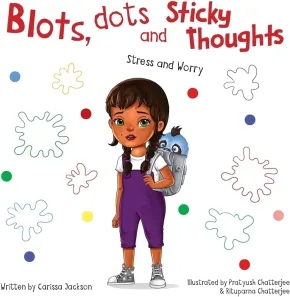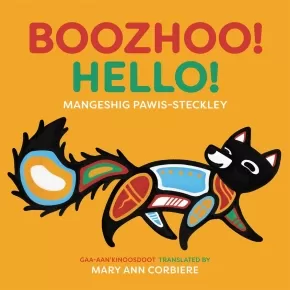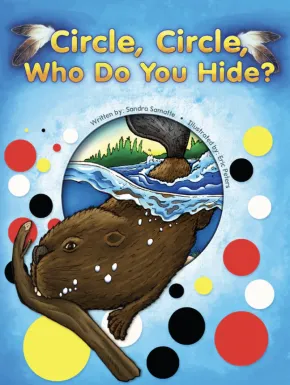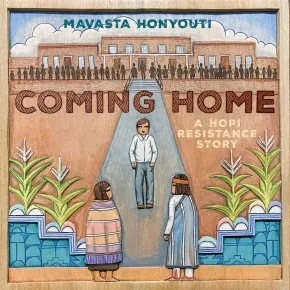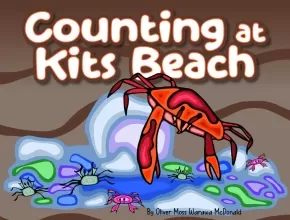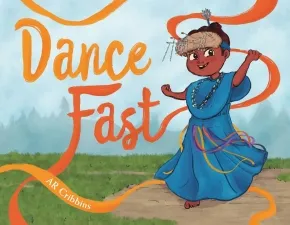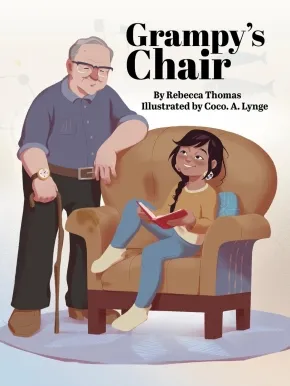
Picture Books
91
-
105
of
606 Results;
Sort By
Go To
of 41
Birth of the Chosen One: A First Nations Retelling of the Christmas Story
$24.99
Format:
Hardcover
Text Content Territories:
Indigenous American; Native American;
ISBN / Barcode: 9781514007020
Synopsis:
Synopsis:
A Fresh Retelling of the Christmas Story!
When they arrived, the time for Bitter Tears to have her child was upon her! But no place could be found in the lodging house, so He Gives Sons found a sheep cave where it was warm and dry.
There, Bitter Tears gave birth to her son. They wrapped him in a soft, warm blanket and laid him on a baby board. Then they placed him on a bed of straw in a feeding trough.
Every year at Christmas, Christians around the world celebrate the birth of Jesus—the Chosen One. Birth of the Chosen One is a unique retelling of this familiar story since it is an adaptation of the Gospel of Luke from the First Nations Version.
Birth of the Chosen One includes:
- The story of Jesus told in the tradition of Native storytellers' oral cultures
- A dynamic equivalence translation of the Christmas story that helps readers of all ages experience Scripture in a fresh and new way
- Illustrations from Native artists Hannah and Holly Buchanan
- A note from the author to encourage further conversation between children and the adults who read with them
Reviews
"It is a gentle, smooth account of Jesus' birth. I pray it reaches a vast audience encouraging each one's effort to search deeper." — Warren D. Petoskey, elder of the Waganakising Odawa and Minneconjou Lakotah nations and author of Dancing My Dream
Educator Information
Recommended for ages 4 to 8.
Additional Information
32 pages | 9.00" x 9.00" | Hardcover
Blots, Dots, and Sticky Thoughts: Stress and Worry
$25.00
Artists:
Format:
Paperback
Text Content Territories:
Indigenous;
ISBN / Barcode: 9781039192751
Synopsis:
Synopsis:
“There is magic in you, there is magic in me, wait, just wait and see!”
And with those words, Lyle’s best friend, a stuffed sloth named Leeto, comes to life! Leeto notices that Lyle is feeling stressed and worried. Lyle has a heavy feeling in her chest, her thoughts are sticky, and her tummy is icky. Leeto knows just what to do, a trip to Present Park will teach them something new.
At Present Park, Lyle and Leeto meet special friends, Coop the bear, Winston the frog, and Nay the budgie. These friends help Lyle and Leeto learn a different way of breathing, they learn to create worry art, and how important it is to put their bodies in motion so their brains can make happy potion.
With Leeto by her side, together they will try all of the activities Present Park has to offer. How will Lyle feel by the end of their adventure?
Educator Information
For ages 5 to 9.
This book teachers children how to recognize the physical and emotional symptoms of stress and worry. The story follows an Indigenous girl and Leeto, her stuffed sloth who comes alive in her mind.
"This book is a passion project for me. In my 25 plus years of experience in the mental health field, I noticed a gap in the literature available for children that deals with emotional intelligence (what am I feeling and experiencing) as well as emotional resilience ( how can I regulate myself and get through stressful times). Gaining self awareness enables children to identify triggers and early signs of stress, allowing for proactive intervention before these strong emotions escalate.
I also recognize the important role parents and care-givers play in supporting children's emotional well-being. For younger children, Blots, Dots and Sticky Thoughts (Stress and Worry) is meant to be assisted reading between parents and their children to generate open dialogue. Open communication about these types of topics foster a supportive and understanding atmosphere where children can speak freely about their emotions.
This story wouldn't be complete without some fun! Lyle and Leeto share a bit of magic as they chant their special phrase to have Leeto come to life. They meet new friends like Coop the bear, Winston the frog, and Nay the budgie who does a hilarious dance called "Giggle Giggle Bum Wiggle"!
This book is excellent for any child who wants to harness their magic and activate their limitless potential." - Cariss Jackson
Additional Information
36 Pages | 8.5" x 8.5" | Paperback
Blue Camas, Blue Camas (PB)
$14.95
Format:
Paperback
Text Content Territories:
Indigenous Canadian; First Nations; Salish; Coast Salish; Songhees (Lekwungen);
ISBN / Barcode: 9781772035247
Synopsis:
Synopsis:
The captivating story of how the Blue Camas, a flower that has been cultivated on Canada’s west coast since time immemorial, came to symbolize the meeting of two contrasting ways of life and the perseverance of traditional knowledge against all odds.
Blue Camas, Blue Camas tells the story of a flower that is native to the Northwest Coast of North America. For thousands of years, it has been considered a sacred and valuable plant by the Indigenous Peoples of this region, who harvested and traded Blue Camas bulbs all along the west coast. At the height of this period, meadows would come alive with the bright wildflowers, which would attract dozens of species of butterflies and birds, and entire villages would work together to harvest the plant and ensure its continued growth.
When Europeans arrived and began to colonize the land, they did not see the value of the Blue Camas plant, and in fact saw the meadows where the plant had been harvested as ideal terrain to grow their own crops. The story takes place at the point of contact between a Lkwungen community and a group of Irish settlers, who see the land in very different ways.
This beautifully illustrated picture book is an ode to a way of life that was threatened and nearly destroyed through miscommunication and colonization. It also raises awareness for food rights, biodiversity, and the preservation of ecosystems, offering children and teachers the opportunity to discuss these important themes in an open and constructive way.
Reviews
"Blue Camas, Blue Camas is a captivating story revealing the overlooked history of colonial contact and its impact on Indigenous communities. Through vivid storytelling and diverse voices, it emphasizes land stewardship, cultural heritage, and fostering empathy, making it a valuable resource for children.”—Samantha Beynon, author of Oolichan Moon
“A beautiful story and an important narrative about the timeline of colonial contact . . . I am happy to share this book with my children.”—Sen’ákw, Senaqwila Wyss, Squamish Nation ethnobotanist
“Danielle S. Marcotte offers a rich, historical perspective of the amazing Blue Camas plant through the eyes of a First Nations family and a settler family.”—Teoni Spathelfer, Heiltsuk author of the Little Wolf Series
“This beautiful story weaves together a rich and important narrative. Family, nature, and the village are all intertwined, with the camas at the centre of it all. So simple and yet so poignant and true!”—Robert "Lucky" Budd, co-author (with Roy Henry Vickers) of the Northwest Coast Legends Series and A Is for Anemone: A First West Coast Alphabet
Educator Information
Recommended for ages 4 to 8.
Additional Information
48 pages | 9.00" x 9.00" | Paperback
Boozhoo! / Hello!
$21.99
Format:
Hardcover
Text Content Territories:
Indigenous Canadian; First Nations; Anishinaabeg; Wasauksing First Nation;
ISBN / Barcode: 9781773067155
Synopsis:
Synopsis:
Hello! Who do you see and hear in the woods today? Meet a variety of woodland and water animals in this story written in Anishinaabemowin and English.
Can you see a fox digging, spot two minnows dancing or hear a swarm of bees buzzing? Boozhoo! / Hello! introduces children to familiar animals as they go about their daily activities: walking, running, swimming, climbing and finally - when the day is done - sleeping! Illustrated in a vibrant and colorful woodland style that will appeal to readers young and old alike, and accompanied by an author's note.
Awards
- 2025 PMC Indigenous Literature Award Winner
Educator Information
Recommended for ages 3 to 6.
Dual-Language: Anishinaabemowin and English.
Translated by Mary Ann Corbiere.
Key Text Features: Author's note, translations, illustrations
Correlates to the Common Core State Standards in English Language Arts:
CCSS.ELA-LITERACY.RL.1.3
Describe characters, settings, and major events in a story, using key details.
CCSS.ELA-LITERACY.RL.1.7
Use illustrations and details in a story to describe its characters, setting, or events.
Additional Information
32 pages | 8.75" x 8.75" | Hardcover
Can You Hear the Plants Speak?
$24.99
Artists:
Format:
Hardcover
Text Content Territories:
Indigenous American; Native American; Apache; Cahuilla;
ISBN / Barcode: 9780063221284
Synopsis:
Synopsis:
Our people believe spirit lives in everything.
Mountain, river, wind, tree.
Come, take a walk with me.
What do we learn from plants when we listen to them speaking? Indigenous plantsman Nicholas Hummingbird calls on the legacy of his great-grandparents to remember how one drop of rain, one seed, one plant can renew a cycle of hope and connection—for him and for each of us.
Perfect for readers of Sy Montgomery, debut authors Nicholas Hummingbird and Julia Wasson joyfully proclaim even the youngest person can be an earth protector. With gorgeous illustrations from Rock Your Mocs artist Madelyn Goodnight, Can You Hear the Plants Speak? encourages us to engage with the natural world.
Educator Information
Recommended for ages 4 to 8.
Additional Information
40 pages | 10.00" x 10.00" | Hardcover
Chooch Helped
$29.99
Artists:
Format:
Hardcover
Text Content Territories:
Indigenous American; Native American; Cherokee;
ISBN / Barcode: 9781646144549
Synopsis:
Synopsis:
A Cherokee girl introduces her younger brother to their family's traditions — begrudgingly! — in this picture book written by Walter Award-winner Andrea L. Rogers and featuring gorgeous collage illustrations from debut artist Rebecca Lee Kunz.
Sissy’s younger brother, Chooch, isn’t a baby anymore. They just celebrated his second birthday, after all. But no matter what Chooch does — even if he’s messing something up! Which is basically all the time! — their parents say he’s just “helping.” Sissy feels that Chooch can get away with anything!
When Elisi paints a mural, Chooch helps. When Edutsi makes grape dumplings, Chooch helps. When Oginalii gigs for crawdads, Chooch helps. When Sissy tries to make a clay pot, Chooch helps . . .
“Hesdi!” Sissy yells. Quit it! And Chooch bursts into tears. What follows is a tender family moment that will resonate with anyone who has welcomed a new little one to the fold. Chooch Helped is a universal story of an older sibling learning to make space for a new child, told with grace by Andrea L. Rogers and stunning art from Rebecca Lee Kunz showing one Cherokee family practicing their cultural traditions.
Awards
- 2025 Randolph Caldecott Medal
Educator Information
Recommended for ages 4 to 8.
Additional Information
48 pages | 9.85" x 10.80" | Hardcover
Circle of Love
$24.99
Artists:
Format:
Hardcover
Text Content Territories:
Indigenous Canadian; First Nations; Cree (Nehiyawak); Indigenous American;
ISBN / Barcode: 9780063078703
Synopsis:
Synopsis:
Everyone is welcome in the circle.
In this warmhearted book, we join Molly at the Intertribal Community Center, where she introduces us to people she knows and loves: her grandmother and her grandmother’s wife, her uncles and their baby, her cousins, and her treasured friends.
They dance, sing, garden, learn, pray, and eat together. And tonight, they come together for a feast! Molly shares with the reader how each person makes her feel—and reminds us that love is love.
Through tender prose and radiant artwork, author Monique Gray Smith (Cree/Lakota) and illustrator Nicole Neidhardt (Diné) show how there is always room for others in our lives. Circle of Love is a story celebrating family, friends, community, and, most of all, love.
Includes an author’s note, contextual notes, and glossary.
Educator Information
Recommended for ages 4 to 8
Additional Information
32 pages | 8.00" x 10.00" | Hardcover
Circle, Circle, Who Do You Hide?
$19.95
Artists:
Format:
Hardcover
Text Content Territories:
Indigenous Canadian;
Grade Levels: Preschool; Kindergarten;
ISBN / Barcode: 9781990297922
Synopsis:
Synopsis:
This fun guessing book features a variety of North American Indigenous animals and is a great repetitive rhyming book that teaches shapes to young children.
Educator Information
Recommended for preschool and kindergarten students.
Additional Information
Hardcover
Clack, Clack! Smack! A Cherokee Stickball Story
$21.99
Artists:
Format:
Hardcover
Text Content Territories:
Indigenous American; Native American; Cherokee; Cherokee Nation (Cherokee Nation of Oklahoma);
ISBN / Barcode: 9781623541934
Synopsis:
Synopsis:
Vann, a struggling stickball player, competes in a game on the Cherokee Nation. Can he help his team win? Written by award-winning Cherokee author Traci Sorell.
Vann loves playing his tribe’s stickball game, but he’s not as skilled as his teammates. Vann stumbles, and he tries and fails to score. How can he help his teammates win?
Exciting and fast-paced, Clack, Clack! Smack! reminds readers that sportsmanship and being a team player is just as important as being the star. Back matter explains the origins of Cherokee stickball.
Reviews
"Two Cherokee teams play a game of stickball in Tahlequah, Oklahoma. Vann feels insecure about having missed a key shot in last week’s match. “Stickball requires speed,” after all, and his “towering body” won’t cooperate. As Vann and his team, the Eagles, take to the field against the Redhawks, they “zip,” “chase,” and “rush” for the ball, their wooden sticks clashing with a “CLACK, CLACK!” Coach gives the team a pep talk in Tsalagi, the Cherokee language. He reminds them of gadugi, the importance of working together. As the players return to the field to finish the game, Vann’s best friend, Jesse, gives him an encouraging smile. The game is now tied. Can Vann and his team win? Sorell and Erb, both members of the Cherokee Nation, deliver an uplifting story of team spirit and collaboration; the emphasis is on group triumphs rather than individual victories. Writing in terse, alliterative prose—“a tackle, a twist, and a wrong turn”—Sorell skillfully builds tension as she choreographs this action-packed game. Erb’s thick-lined cartoon illustrations have a pleasing solidity; they capture the chaos and drama of the game and depict players with a range of brown skin tones. The story features frequent Tsalagi words and phrases. Backmatter stresses the importance of keeping the Cherokee language alive and explains the significance of stickball, which traditionally was used to settle conflicts. Stand and cheer for this fast-paced tale of sportsmanship and community." —Kirkus Reviews
Educator Information
Recommended for ages 4 to 7.
Additional Information
32 pages | 8.38" x 10.31" | Hardcover
Clyde River, My Home
$16.95
Artists:
Format:
Paperback
Grade Levels: Preschool; Kindergarten;
ISBN / Barcode: 9781774507711
Synopsis:
Synopsis:
Clyde River, Nunavut is a great place to live! In this bilingual picture book, Louise tells us about all the things she and her family like to do. With the annual fishing derby in the spring and Hamlet Day in the summer, there are lots of fun things to do throughout the year. Winter brings plenty of time to connect with people in the community and support each other. Learn about the different activities people do in each season in Clyde River, its landmarks, and the amazing wildlife you can see there, like bowhead whales.
Reviews
"This bilingual book, written in English and Inuktitut, follows young Louise as she shares her deep connection to Clyde River, Nunavut, her childhood home. Through vivid descriptions of community sites and seasonal traditions, Louise offers readers a glimpse into Inuit life, blending modern and Traditional practices. Site names are given in both languages to celebrate cultural preservation and identity. As Louise’s story reflects the author’s own roots, the narrative feels intimate and authentic. The book encourages understanding of Canada’s diverse cultures and fosters appreciation of Inuit heritage and storytelling." - Anika L., Middle School Teacher, Indigenous Books for Schools
Educator & Series Information
Recommended for ages 3 to 5.
Dual-Language: English & Inuktitut
This book is part of the Community Connections series.
This book is included in the Indigenous Books for Schools database from the Association of Book Publishers of BC. It is recommended for Grades 2 to 5 for English Language Arts and Social Studies.
Additional Information
27 pages | 8.00" x 10.00" | Paperback
Coming Home: A Hopi Resistance Story
$28.99
Artists:
Format:
Hardcover
ISBN / Barcode: 9781646144570
Synopsis:
Synopsis:
From master Hopi woodcarver Mavasta Honyouti, the story of his grandfather’s experience at a residential boarding school and how he returned home to pass their traditions down to future generations.
When Mavasta Honyouti was a boy he would go with his grandfather to their cornfield, watching him nurture every plant. During breaks, his grandfather would take out a piece of paako root and use his pocketknife to whittle away. He made beautiful carvings that Mavasta would later learn to do himself.
But Mavasta would often wonder: what was his kwa’a like when he was a boy? And one day, he heard the story.
Mavasta’s grandfather, like many Native American children across the country in the late 19th and early 20th century, was forced to leave his Hopi reservation as a child and go to a residential boarding school far away. There, the government cut his hair, punished him for speaking his native language, and gave him a new name. But Mavasta's grandfather never forgot who he was – or where he came from – and he tried to escape again and again. Finally, he made it back to their reservation.
In later years, Mavasta’s kwa’a chose a simple life, taking great care of his family just like he took great care of his plants. His son and later his grandson became acclaimed Hopi katsina woodcarvers, just like him. Coming Home: A Hopi Resistance Story is a deeply personal book – written in both English and Hopi – that features sixteen stunning original painted wood carvings. It is an unforgettable testament to one man rising above a painful piece of history to keep the light of his family and culture alive.
Educator Information
Recommended for ages 4 to 8.
Dual-language: English and Hopi.
Additional Information
48 pages | 9.00" x 9.20" | Hardcover
Counting at Kits Beach (BB)
$15.00
Artists:
Format:
Paperback
Text Content Territories:
Indigenous Canadian; First Nations; Cree (Nehiyawak);
ISBN / Barcode: 9781928120438
Synopsis:
Synopsis:
Learning to count is easy and fun with Counting at Kits Beach. Follow Oliver McDonald’s delightful and colourful pictures, which count various beings at Kits (Kitsilano) Beach, Vancouver. The images begin at ten and count down to one, the last being the sunset. Then come back to Kits Beach and watch and count again. Children ages three to six will love Counting at Kits Beach!
Reviews
"McDonald’s colourful and artfully illustrated children’s book Counting at Kits Beach is a beautiful celebration of life by the ocean at Kitsilano Beach, with a counting theme. Children will be engaged by the vibrant illustrations and depictions of the ocean wildlife, fishermen, boats, and bunnies. There are also reflective counting questions at the end to reinforce the theme.
This book would be a welcome addition to any classroom or library, especially those near the coast or ocean. Children will love exploring this book and reflecting on their own experiences by the water." - Lori B., Indigenous Educator & Administrator, Indigenous Books for Schools
Educator Information
Recommended for ages 3 to 6.
This book is included in the Indigenous Books for Schools database from the Association of Book Publishers of BC. It is recommended for K to 2 classrooms for English Language Arts, Social Studies, and Mathematics.
Additional Information
24 pages | 8.00" x 6.50"
Dance Fast
$24.99
Artists:
Text Content Territories:
Indigenous American; Native American; Pomo;
ISBN / Barcode: 9780316539388
Synopsis:
Synopsis:
This charming and humorous book celebrates Pomo traditions and explores creative frustration, perfectionism, and the value in embracing your mistakes.
I want to dance!
Bizzy can't wait to dance with all her friends and family at the summer gathering this year! But first, she must make the perfect regalia. It's tricky work, even with a grown-up's help, and her high expectations come crashing down in a flurry of torn fabric, loose beads, and tears. With support from her mom, grandma, and little brother, can Bizzy learn to see past the flaws, finish her work, and remember what's really important?
AR Cribbins celebrates Pomo traditions in this charming and humorous tale about creativity and perfectionism.
Reviews
“The illustrations are bright and energetic and mirror Bizzy’s emotional undulations.”—Booklist
“The many emotions of all the characters are wonderfully encapsulated in the imagery through collage and comic book–style cartoons…. This book teaches in a safe, digestible story that accidents happen, emotions will rise, but having support can help repair the situation smoother than attempting to fix it with those immediate big feelings.”—School & Library Journal
“A vibrantly illustrated life lesson.”—Kirkus
Educator Information
Recommended for ages 4 to 8.
Additional Information
40 pages | 8.80" x 11.40" | Hardcover
Elizabeth Quocksister: Keeper of History (PB)
$12.95
Artists:
Format:
Paperback
Text Content Territories:
Indigenous Canadian; First Nations; Kwakwaka'wakw (Kwakiutl); Da'naxda'xw Awaetlala;
ISBN / Barcode: 9781772034851
Synopsis:
Synopsis:
The uplifting true story of Elizabeth Quocksister, a strong Indigenous woman and community leader, who dedicated her life to protecting her language and cultural traditions.
Elizabeth Quocksister (1925–81) had many roles in her life. She was a cultural teacher, a community leader, a dancer, a nurse, a photographer, a residential school survivor, and a mother of ten. Born on the Da’naxda’xw Nation on Knight Inlet on the central coast of British Columbia, Elizabeth spoke fluent Kwak’wala and proudly celebrated her Kwakwaka’wakw culture at a time when the Canadian government actively discouraged Indigenous traditions and the speaking of Indigenous languages. She cared for community members in need and saved many children from the horrors of residential school. She chronicled the daily lives, important events, and changing times of her community through photography—preserving her people’s history and culture for future generations. This inspiring picture book is a beautiful tribute to a proud Indigenous woman whose name deserves to be well-known throughout her community and beyond.
Educator Information
Recommended for ages 4 to 8.
Additional Information
32 pages | 9.00" x 9.00" | Paperback
Grampy's Chair
$23.99
Artists:
Format:
Hardcover
Text Content Territories:
Indigenous Canadian; First Nations; Mi'kmaq;
ISBN / Barcode: 9781773219189
Synopsis:
Synopsis:
A heartwarming story about lifelong love and loss told from the perspective of a grandfather’s favorite chair.
Grampy’s chair sits in the middle of his living room and always keeps an eye on My Love. The Chair is the perfect spot for My Love to learn to read, to play games with her friends, and The Chair is always extra soft when My Love is sick. As My Love grows up, The Chair sees Grampy grow older and My Love must care for him. One day Grampy is gone, and The Chair is moved to a space with only a few things it recognizes (and a few spiders too). Will it see My Love again?
In this poignant story inspired by her own grandfather and his chair, Rebecca Thomas invites readers of all ages to explore love, grief, and the important moments in life that take place in our favorite spots. With lively illustrations from Coco A. Lynge and featuring a heartfelt author’s note, Grampy's Chair takes the readers through loss, and how we can be found again by the ones we love.
Reviews
"Although the author is Mi’kmaw, the story does not directly reference Mi’kmaw culture. Instead, it draws on her personal experience in a mixed-heritage family and offers a heartfelt reflection on the loss of a grandparent. Thomas’s poetic voice invites readers to reflect on someone special and the emotional meaning attached to everyday objects, such as a chair, photograph, or place. Lynge’s gentle illustrations enrich the story’s emotional tone, helping readers connect with the emotions expressed in the story. Suitable for K–3 classrooms, this picture book supports curricular connections in English Language Arts and Social Studies. In ELA, it invites exploration of perspective, voice, symbolism, and story structure. In Social Studies, it can spark discussion around family diversity, intergenerational knowledge, and memory." - Bonny-Lynn D., Elementary School Teacher, Indigenous Books for Schools
Educator Information
Recommended for ages 4 to 7.
This book is included in the Indigenous Books for Schools database from the Association of Book Publishers of BC. It is recommended for K to 3 classrooms for English Language Arts and Social Studies.
Additional Information
36 pages | 7.65" x 10.25" | Hardcover
Sort By
Go To
of 41



